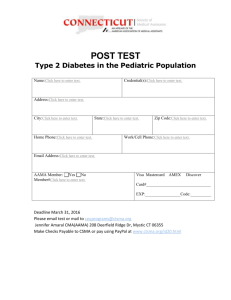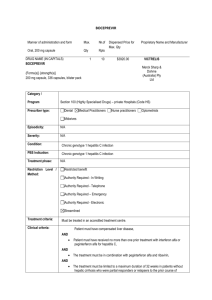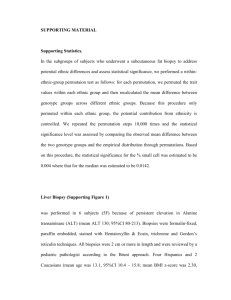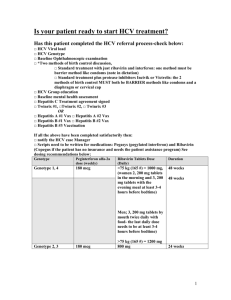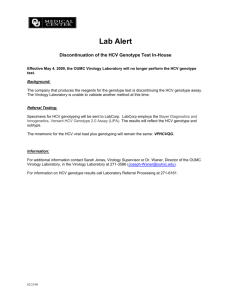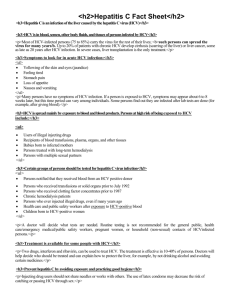Etude in vitro de la stéatose hépatique induite par la - HAL
advertisement
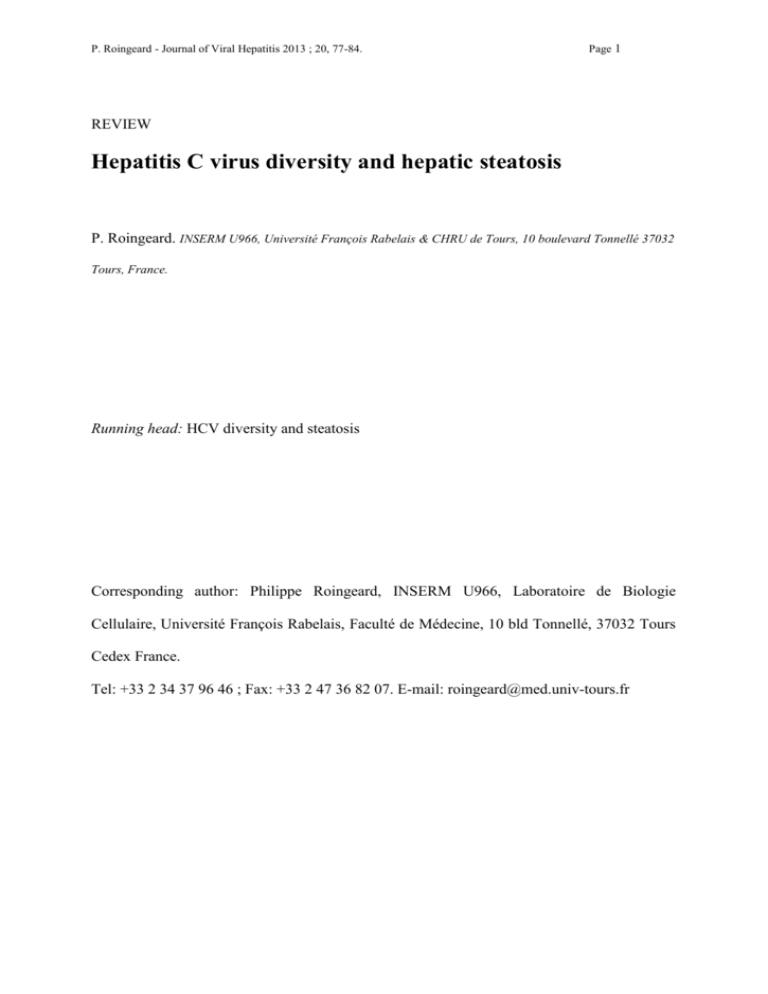
P. Roingeard - Journal of Viral Hepatitis 2013 ; 20, 77-84. Page 1 REVIEW Hepatitis C virus diversity and hepatic steatosis P. Roingeard. INSERM U966, Université François Rabelais & CHRU de Tours, 10 boulevard Tonnellé 37032 Tours, France. Running head: HCV diversity and steatosis Corresponding author: Philippe Roingeard, INSERM U966, Laboratoire de Biologie Cellulaire, Université François Rabelais, Faculté de Médecine, 10 bld Tonnellé, 37032 Tours Cedex France. Tel: +33 2 34 37 96 46 ; Fax: +33 2 47 36 82 07. E-mail: roingeard@med.univ-tours.fr P. Roingeard - Journal of Viral Hepatitis 2013 ; 20, 77-84. Page 2 SUMMARY. Hepatitis C virus (HCV) infection is closely associated with lipid metabolism defects throughout the viral lifecycle, with hepatic steatosis frequently observed in patients with chronic HCV infection. Hepatic steatosis is most common in patients infected with genotype 3 viruses, possibly due to direct effects of genotype 3 viral proteins. Hepatic steatosis in patients infected with other genotypes is thought to be mostly due to changes in host metabolism, involving insulin resistance in particular. Specific effects of the HCV genotype 3 core protein have been observed in cellular models in vitro: mechanisms linked to a decrease in microsomal triglyceride transfer protein activity, decreases in the levels of peroxisome proliferator-activating receptors, increases in the levels of sterol regulatory element-binding proteins, and phosphatase and tensin homologue downregulation. Functional differences between the core proteins of genotype 3 viruses and viruses of other genotypes may reflect differences in amino-acid sequences. However, bioclinical studies have failed to identify specific “steatogenic” sequences in HCV isolates from patients with hepatic steatosis. It is therefore difficult to distinguish between viral and metabolic steatosis unambiguously and host and viral factors are probably involved in both HCV genotype 3 and non-3 steatosis. Key words: hepatitis C virus, HCV, genotype, lipid droplet, hepatic steatosis. P. Roingeard - Journal of Viral Hepatitis 2013 ; 20, 77-84. Page 3 INTRODUCTION Hepatic steatosis, defined as excessive lipid accumulation in the cytoplasm of hepatocytes, is a frequent histological feature in patients chronically infected with hepatitis C virus (HCV) (Figure 1). Before the identification and characterisation of HCV in 1989, the presence of steatosis was used to discriminate between so-called “non-A non-B” hepatitis and other forms of chronic liver disease, such as hepatitis B or autoimmune hepatitis. This suggests a probable direct role for HCV in the development of excess fat accumulation in the liver. However, the mechanisms underlying hepatic steatosis in HCV-infected patients are difficult to unravel, due to the possible co-existence of several confounding factors, including metabolic syndrome, type 2 diabetes, obesity and a high body mass index (BMI), in patients. These cofactors may occur together in HCV patients and may cause various degrees of hepatic steatosis through mechanisms similar to those of classical non-alcoholic fatty liver disease (NAFLD), mostly through insulin resistance [1, 2]. Furthermore, hepatic steatosis may result from other challenges to the liver, particularly in cases of excessive alcohol consumption. It has been suggested that there are two main types of steatosis in patients with hepatitis C. The first is a metabolic type of steatosis associated with a high BMI, hyperlipidaemia and insulin resistance. The second is a virally induced form of steatosis that develops in the absence of other “steatogenic” cofactors and that seems to be directly triggered by the virus. The situation is further complicated by the possible role of HCV as a cofactor in the development of the metabolic type of steatosis, this virus has itself been shown to induce insulin resistance, potentially favouring the development of hepatic steatosis [3, 4]. Nevertheless, virally induced steatosis is widely considered to be predominantly, and perhaps strictly, linked to HCV genotype 3 infection [5]. The HCV RNA genome displays considerable diversity, both within and between isolates, and three levels of classification have been adopted, grouping viral sequences into six genotypes, several dozen subtypes and P. Roingeard - Journal of Viral Hepatitis 2013 ; 20, 77-84. Page 4 intra-isolate variants. Hepatic steatosis is common in patients infected with genotype 3 viruses and seems to be directly related to intrahepatic viral load, suggesting a direct viral effect that is not observed with other genotypes [6]. Moreover, following successful HCV eradication by antiviral therapy, hepatic steatosis resolves in most individuals infected with genotype 3 viruses, but not in those infected with genotype 1 viruses [7]. Further evidence supporting this link has been provided by in vitro studies showing that the HCV core protein induces lipid droplet (LD) accumulation that is more pronounced with genotype 3 proteins than with proteins from viruses of other genotypes [8-10]. In this review, I discuss the basic and clinical aspects of this link between HCV diversity, including genotype classification, and steatosis development. MOLECULAR MECHANISMS OF HCV-INDUCED STEATOSIS The close association of HCV with steatosis should probably be analysed in the light of evidence from many basic studies demonstrating that the virus hijacks the lipid-producing machinery of the hepatocyte for its own benefit. In cell culture, the HCV core protein associates with lipid droplets (LD) [11], inducing the clustering and accumulation of these lipid storage organelles [12, 13]. This LD clustering and accumulation might be the consequence of a decrease in LD turnover induced by the interaction of the HCVcore protein with a host cell enzyme that synthesizes triglycerides in the ER, the diacylglycerol acyltransferase 1 (DGAT1) [14, 15]. HCV virions are then formed at endoplasmic reticulum (ER) membranes directly apposed to these clustered LD [16, 17], suggesting that virusinduced steatosis may be a consequence of viral lifecycle strategy [18]. HCV particles are then secreted and circulate as very low-density lipoprotein (VLDL)-virus complexes rich in triglycerides [19]. These particles, which are known as lipoviro particles (LVPs), contain viral P. Roingeard - Journal of Viral Hepatitis 2013 ; 20, 77-84. Page 5 RNA, viral structural proteins (core and envelope E1 and E2 proteins) and the host-derived apolipoproteins B and E (apoB and apoE) [19]. Specific mechanisms have been proposed to account for virally induced steatosis. These mechanisms involve decreases in the levels of microsomal triglyceride transfer protein (MTP), and peroxisome proliferator-activating receptors (PPARs), increases in sterol regulatory element binding protein (SREBP) levels, oxidative stress due to the production of reactive oxygen species (ROS) and phosphatase and tensin homologue (PTEN) downregulation (Figure 2). MTP MTP, which is present in the ER lumen, stabilises apoB by lipidation. Lipidated apoB binds triglycerides, forming VLDL for export from hepatocytes. HCV core [20] and non-structural proteins [21] have been shown to decrease the activity of MTP, resulting in the accumulation of intracellular lipids due to a decrease in VLDL export. Several studies have reported low serum triglyceride concentrations in patients chronically infected with HCV [22]. In human liver biopsy specimens, MTP mRNA levels are inversely correlated with the degree of hepatic steatosis, regardless of HCV genotype [23]. However, patients infected with genotype 3 viruses have significantly lower levels of MTP activity than patients infected with other genotypes [23], suggesting that genotype 3 viral proteins may also directly inhibit MTP activity. PPARs The PPAR nuclear receptors belong to the steroid superfamily. PPAR is strongly expressed in hepatocytes, in which it regulates lipid metabolism through fatty acid import into mitochondria and the activation of oxidative enzymes. Decreases in PPARactivity probably P. Roingeard - Journal of Viral Hepatitis 2013 ; 20, 77-84. Page 6 cause fatty acid uptake and a decrease in mitochondrial oxidation, resulting in hepatic steatosis. Liver biopsy specimens from patients with chronic HCV infection have been shown to contain lower levels of PPARand its target gene transcripts than specimens from controls [24]. More detailed analyses have shown that PPAR mRNA levels are even lower in patients infected with genotype 3 viruses than in those infected with genotype 1 viruses [25], suggesting that this inhibition may also involve genotype-dependent mechanisms. SREBPs SREBPs constitute a family of ER membrane-associated transcription factors that regulate the production of enzymes involved in lipogenesis. The SREBP-1c isoform is produced predominantly in the liver. In its inactivated form, it binds the SREBP cleavage-activating protein (SCAP). Low intracellular sterol concentrations lead to cleavage from SCAP, the resulting SREBP being translocated to the nucleus (nuclear SREBP; nSREBP), where it binds to the SREBP response element (SRE), up-regulating the transcription of genes involved in lipogenesis. Various methods accounting for the increase in lipogenesis due to SRBP activation by HCV have been described in cellular models in vitro. SREBP mRNA levels increase in cells producing the HCV core protein, resulting in an increase in fatty acid synthesis within hepatocytes [26]. It was shown in an in vitro study that fatty acid synthetase (FAS) was more strongly induced, in an SRBP1c-dependent manner, by genotype 3 core proteins than by genotype 1 core proteins [27]. However, these results were called into question by a study reporting a lack of specific increase in the expression of genes involved in lipogenesis following SREBP activation in the livers of patients infected with genotype 3 viruses [28]. HCV-induced oxidative stress and the subsequent activation of the phosphatidylinositol 3-kinase (PI3-K)-Akt pathway and PTEN inactivation have also been shown to mediate the transactivation of SREBPs [29]. Again, this phenomenon was found to P. Roingeard - Journal of Viral Hepatitis 2013 ; 20, 77-84. Page 7 be more marked with genotype 3 core protein than with genotype 1 core protein. Finally, the non-structural NS2 protein has also been shown to activate SREBPs in human hepatic cell lines [30]. Oxidative stress HCV core protein directly increases the level of ROS products by inhibiting electron transport and modifying mitochondrial permeability [31, 32]. This ROS production leads to the peroxidation of membrane lipids and proteins involved in trafficking and secretion, inhibiting VLDL secretion. In addition to the direct effects of HCV proteins on the mitochondria, HCVinduced immune activation may also cause oxidative stress through cytokine release and macrophage activation. Moreover, the release of proinflammatory cytokines, such as tumour necrosis factor (TNF), further promotes insulin resistance, which may in turn favour the development of hepatic steatosis. PTEN A new mechanism specifically attributable to the HCV core protein of genotype 3 isolates has recently been proposed [33]. PTEN, the intrahepatic downregulation of which has been shown to contribute to the development of steatosis in NAFLD, has been shown to be downregulated by a genotype 3 core protein in cellular models in vitro, via a mechanism involving a microRNA-dependent blockade of PTEN mRNA translation. By contrast, no such effect is observed with genotype 1 core protein. HCV AND INSULIN RESISTANCE Like metabolic syndrome, chronic HCV infection is associated with insulin resistance [34]. Glucose metabolism is modified to a significantly greater extent in the early stages of chronic P. Roingeard - Journal of Viral Hepatitis 2013 ; 20, 77-84. Page 8 HCV infection than in chronic hepatitis B virus (HBV) infection. HCV infection thus causes insulin resistance, which can progress to type 2 diabetes mellitus in susceptible individuals [35]. Various mechanisms have been put forward to account for the induction of insulin resistance by HCV. Direct effects in hepatocytes have been attributed to viral interference with the insulin signal transduction pathway mediated by HCV core protein and to the ER stress induced by viral replication (reviewed in [36]). However, insulin resistance has also been shown to occur in uninfected cells, such as striated muscle cells, by unknown mechanisms [3]. Interestingly, the adipose tissue did not appear to be involved in the pathogenesis of viral insulin resistance, as free fatty acid efflux from adipose tissue responds to insulin in normal persons and in patients with chronic hepatitis C [3]. Liver tissues contain large numbers of insulin receptors. The liver controls hepatic glucose production, the replenishment of glycogen stores, increases in triglyceride biosynthesis and decreases in VLDL and apoB production and secretion. In conditions of insulin resistance, hepatic steatosis has been shown to occur principally due to an increase in the influx of fatty acids into the liver, as a result of higher levels of peripheral lipolysis and hepatic lipogenesis [37]. Decreases in fatty acid oxidation and fat export further contribute to hepatic steatosis [38]. Furthermore, hyperinsulinaemia leads to the direct activation of SREBP-1c, causing lipogenesis [38]. Patients with chronic HCV infection have significantly higher fasting serum insulin concentrations and homeostatic model assessments (HOMAR-IR, a marker for insulin resistance) than healthy volunteers [39, 40]. Moreover, patients infected with a genotype 3 virus have significantly lower HOMA-IR values than patients infected with other genotypes, providing support for the widely held view that hepatic steatosis is virally induced in genotype 3 infections but metabolically induced in infections with other genotypes [39, 40]. P. Roingeard - Journal of Viral Hepatitis 2013 ; 20, 77-84. Page 9 HCV SEQUENCES INVOLVED IN STEATOSIS Studies in early experimental in vitro expression systems and transgenic mouse models showed that the HCV core protein was sufficient to induce triglyceride accumulation in hepatocytes [20, 41, 42]. All these early reports were based on studies using constructs derived from a genotype 1 genome. More recent investigations have been conducted with in vitro cellular models expressing the HCV genotype 3 core protein that has been found to result in higher levels of triglyceride accumulation than the genotype 1 core protein [8]. These functional differences between genotype 1 and 3 core proteins may result from differences in their amino-acid sequences, although these sequences are very similar. The search for viral sequences responsible for genotype 3 core protein-specific effects on triglyceride accumulation led to the identification of a single amino-acid change, at position 164 [9]. A phenylalanine (F) residue in this position, as found in genotype 3 core sequences, has been shown to be specifically associated with higher levels of lipid droplet accumulation in cellular models in vitro. In almost all the core sequences of viruses of other genotypes, this residue is replaced by a tyrosine (Y) [9]. Similarly, higher levels of lipid droplet accumulation were observed in a study in which an HCV core protein sequence from a genotype 3 virus was produced in a cellular model [8]. However, the authors were unable to identify the residues involved in this phenomenon, and did not implicate F164. Nevertheless, this particular residue was directly implicated in the stronger FAS activation observed with the genotype 3 core protein [27]. Another study reporting the sequencing of the core gene from genotype 3 viruses infecting patients with or without steatosis led to the identification of two additional residues correlated with lipid accumulation: phenylalanine-valine (FV) or leucine-isoleucine (LI) at positions 182 and 186 (as opposed to FI) [10]. The production in vitro of core proteins with these FV or LI residues resulted in significantly higher intracellular lipid levels than the production of core proteins with FI residues in these positions. However, in two other P. Roingeard - Journal of Viral Hepatitis 2013 ; 20, 77-84. Page 10 independent studies, analyses of the sequences of various clinical isolates failed to implicate the FV and LI residues in positions 182 and 186, or any other genetic differences between genotype 3 core proteins from patients with and without steatosis, suggesting a possible role for other factors in the development of steatosis in patients infected with genotype 3 viruses [43, 44]. In all these bioclinical studies, it was difficult to evaluate the role of the F164 residue in liver steatosis, because this residue was present in all genotype 3 isolates, even those from patients without steatosis [10, 43, 44] (Figure 3). Nevertheless, an F residue was never detected in position 164 in any of the genotype 1 strains associated with severe steatosis [44]. Overall, studies using in vitro cellular models to compare the intracellular lipid accumulation induced by genotype 3 and genotype 1 core proteins have not generated consistent results [810, 27, 43] (Figure 3). These differences may be due to the different cell models and lipid droplet quantification methods used in these studies. One might assume that human liver cell lines would constitute the best model, but Huh7 cells have been reported to have intracellular lipid levels in standard culture conditions too high for the detection of meaningful differences between the proteins studied [10]. This was confirmed with the HCV in cell culture (HCVcc) model, as viruses bearing structural proteins (the core and envelope E1 and E2 proteins) from a genotype 2 or a genotype 3 strain induced the accumulation of similar numbers of lipid droplets when propagated in Huh7 cells [45]. Furthermore, despite a polymorphism between the genotype 2 strains J6 and JFH1 at residue 164 (Y in JFH-1, F in J6), the propagation of JFH-1 and J6/JFH-1 HCVcc in Huh7 cells did not result in any significant differences in lipid droplet amount (unpublished personal observation). However, one study comparing these two viruses has shown that a virus bearing the J6 core sequence is more efficiently assembled and secreted from infected cells, but has lower ability to induce the LD clustering [46]. This suggests that the viral assembly efficiency by itself might influence the lipid storage, through the core protein dependent use of the LD as viral assembly platform. Thus, even if the core P. Roingeard - Journal of Viral Hepatitis 2013 ; 20, 77-84. Page 11 protein is central in this process, the effect of the HCV infection on the cellular lipid load might also depend on the interaction between this protein and other viral partners involved in virion assembly. Interestingly, the binding of the core protein to the non-structural NS5A protein is critical for virus particle assembly [47], and this protein has been shown to also interact with lipid metabolism [48], inducing steatosis in a transgenic mouse model [49]. As a result, one bioclinical study also analysed the NS5A sequences of the viral variants circulating in patients with and without steatosis [44]. No differences in the sequence of the NS5A gene were found between patients with and without steatosis, suggesting that other viral proteins and, probably, host factors are involved in the development of steatosis in genotype 3 infection. However, although recent data have suggested that the polymorphism of various host genes, including the PPAR, IL-28B, adiponutrin and MTP genes, may influence the development of more severe steatosis in chronic carriers of HCV, this phenomenon seems to concern principally patients infected with non-genotype 3 viruses [50-56]. OTHER POTENTIAL LINKS BETWEEN HCV GENOTYPE 3 AND HEPATIC STEATOSIS In Western Europe, genotype 3 infection is more frequent in patients with a history of intravenous drug use (IVDU) than in non-drug users [57]. Moreover, alcohol abuse has been reported to be particularly frequent in patients with a history of IVDU [58, 59]. Therefore, although this relationship is certainly not strict and remains speculative, these observations suggest that alcohol consumption may be associated with a HCV genotype 3 infection, at least in some patients. This is of potential importance, as ethanol metabolism also causes mitochondrial injury and is thought to act in synergy with HCV to produce ROS [60]. P. Roingeard - Journal of Viral Hepatitis 2013 ; 20, 77-84. Page 12 CONCLUSION Several studies have shown an association between steatosis and the progression of liver fibrosis and advanced liver disease in chronic hepatitis [61]. Virally induced steatosis does not seem to be associated with advanced stages of fibrosis and the association described in previous reports may essentially be due to metabolic steatosis [62]. However, the failure to identify unambiguously specific “steatogenic” sequences in genotype 3 isolates from patients with hepatic steatosis suggests that there is no clear dichotomy between virally induced and metabolically induced hepatic steatosis. The overlap between the two forms of steatosis in chronic carrier of HCV may be greater than previously thought and further studies are clearly required to improve our understanding of the relationship and molecular interactions between these two forms. ACKNOWLEDGEMENTS Work on HCV and hepatic steatosis in my laboratory is currently supported by grants from INSERM-DHOS and the Ligue Contre le Cancer (Comités d’Indre & Loire et de l’Ile & Vilaine). Electron microscopy data were obtained with the assistance of the RIO EM facility of François Rabelais University. I thank E Beaumont, M. Depla, F. Dubois, C. Hourioux and E. Piver for useful discussions. REFERENCES 1 Cammà C, Bruno S, Di Marco V, et al. Insulin resistance is associated with steatosis in nondiabetic patients with genotype 1 chronic hepatitis C. Hepatology 2006; 43: 64-71. 2 Moucari R, Asselah T, Cazals-Hatem D, et al. Insulin resistance in chronic hepatitis C: association with genotypes 1 and 4, serum HCV RNA level, and liver fibrosis. Gastroenterology 2008 ; 134: 416-423. P. Roingeard - Journal of Viral Hepatitis 2013 ; 20, 77-84. 3 Page 13 Vanni E, Abate ML, Gentilcore E, et al. Sites and mechanisms of insulin resistance in nonobese, nondiabetic patients with chronic hepatitis C. Hepatology 2009; 50: 697-706. 4 Milner KL, van der Poorten D, Trenell M, et al. Chronic hepatitis C is associated with peripheral rather than hepatic insulin resistance. Gastroenterology 2010; 138: 932-941. 5 Cross TJ, Rashid MM, Berry PA, Harrison PM. The importance of steatosis in chronic hepatitis C infection and its management. Hepatol Res 2010; 40: 237-247. 6 Rubbia-Brandt L, Quadri R, Abid K, et al. Hepatocyte steatosis is a cytopathic effect of hepatitis C virus genotype 3. J Hepatol 2000; 33: 106-115. 7 Castera L, Hezode C, Roudot-Thoraval F, et al. Effect of antiviral treatment on evolution of liver steatosis in patients with chronic hepatitis C: indirect evidence of a role of hepatitis C virus genotype 3 in steatosis. Gut 2004; 53: 420-424. 8 Abid K, Pazienza V, de Gottardi A, et al. An in vitro model of hepatitis C virus genotype 3a-associated triglyceride accumulation. J Hepatol 2005; 42: 744-751. 9 Hourioux C, Patient R, Morin A, et al. The genotype 3-specific hepatitis C virus core protein residue phenylalanine 164 increases steatosis in an in vitro cellular model. Gut 2007; 56: 1302-1308. 10 Jhaveri R, McHutchison J, Patel K, Qiang G, Diehl AM. Specific polymorphisms in hepatitis C virus genotype 3 core protein associated with intracellular lipid accumulation. J Infect Dis 2008; 197: 283-291. 11 Hourioux C, Ait-Goughoulte M, Patient R, et al. Core protein domains involved in hepatitis C virus-like particle assembly and budding at the endoplasmic reticulum membrane. Cell Microbiol 2007; 9: 1014-1027. P. Roingeard - Journal of Viral Hepatitis 2013 ; 20, 77-84. 12 Page 14 Depla M, Uzbekov R, Hourioux C, et al. Ultrastructural and quantitative analysis of the lipid droplet clustering induced by hepatitis C virus core protein. Cell Mol Life Sci 2010; 67: 3151-3161 13 Roingeard P, Depla M. The birth and life of lipid droplets: learning from the hepatitis C virus. Biol Cell 2011; 103: 223-231. 14 Herker E, Harris C, Hernandez C, et al. Efficient hepatitis C virus particle formation requires diacylglycerol acyltransferase-1. Nat Med 2010; 16: 1295-1298. 15 Harris C, Herker E, Farese RV, Ott M. Hepatitis C virus core protein decreases lipid droplet turnover : a mechanism for core-induced steatosis. J Biol Chem 2011; 286: 42615-42625. 16 Miyanari Y, Atsuzawa K, Usuda N, et al. The lipid droplet is an important organelle for hepatitis C virus production. Nat Cell Biol 2007; 9: 1089-1097. 17 Roingeard P, Hourioux C, Blanchard E, Prensier G. Hepatitis C virus budding at lipid droplet-associated ER membrane visualized by 3D electron microscopy. Histochem Cell Biol 2008; 130: 561-566. 18 Roingeard P, Hourioux C. Hepatitis C virus core protein, lipid droplets and steatosis. J Viral Hepat 2008; 15: 157-164. 19 Bartenschlager R, Penin F, Lohmann V, André P. Assembly of infectious hepatitis C virus particles. Trends Microbiol 2011; 19: 95-103 20 Perlemuter G, Sabile A, Letteron P, et al. Hepatitis C virus core protein inhibits microsomal triglyceride transfer protein activity and very low density lipoprotein secretion: a model of viral-related steatosis. FASEB J 2002; 16: 185-194. P. Roingeard - Journal of Viral Hepatitis 2013 ; 20, 77-84. 21 Page 15 Domitrovich AM, Felmlee DJ, Siddiqui A. Hepatitis C virus nonstructural proteins inhibit apolipoprotein B100 secretion. J Biol Chem 2005; 280: 39802-39808. 22 Siagris D, Christofidou M, Theocharis GJ, et al. Serum lipid pattern in chronic hepatitis C: histological and virological correlations. J Viral Hepat 2006; 13: 56-61. 23 Mirandola S, Realdon S, Iqbal J, et al. Liver microsomal triglyceride transfer protein is involved in hepatitis C liver steatosis. Gastroenterology 2006; 130: 1661-1669. 24 Dharancy S, Malapel M, Perlemuter G, et al. Impaired expression of the peroxisome proliferator-activated receptor alpha during hepatitis C virus infection. Gastroenterology 2005; 128: 334-342. 25 de Gottardi A, Pazienza V, Pugnale P, et al. Peroxisome proliferator-activated receptoralpha and -gamma mRNA levels are reduced in chronic hepatitis C with steatosis and genotype 3 infection. Aliment Pharmacol Ther 2006; 23: 107-114. 26 Kim KH, Hong SP, Kim K, Park MJ, Kim KJ, Cheong J. HCV core protein induces hepatic lipid accumulation by activating SREBP1 and PPARgamma. Biochem Biophys Res Commun 2007; 355: 883-888. 27 Jackel-Cram C, Babiuk LA, Liu Q. Up-regulation of fatty acid synthase promoter by hepatitis C virus core protein: genotype-3a core has a stronger effect than genotype-1b core. J Hepatol 2007; 46: 985-987. 28 Ryan MC, Desmond PV, Slavin JL, Congiu M. Expression of genes involved in lipogenesis is not increased in patients with HCV genotype 3 in human liver. J Viral Hepat 2011; 18: 53-60. 29 Waris G, Felmlee DJ, Negro F, Siddiqui A. Hepatitis C virus induces proteolytic cleavage of sterol regulatory element binding proteins and stimulates their phosphorylation via oxidative stress. J Virol 2007; 81: 8122-8130. P. Roingeard - Journal of Viral Hepatitis 2013 ; 20, 77-84. 30 Page 16 Oem JK, Jackel-Cram C, Li YP, et al. Activation of sterol regulatory element-binding protein 1c and fatty acid synthase transcription by hepatitis C virus non-structural protein 2. J Gen Virol 2008; 89: 1225-1230. 31 Korenaga M, Wang T, Li Y, et al. Hepatitis C virus core protein inhibits mitochondrial electron transport and increases reactive oxygen species (ROS) production. J Biol Chem 2005; 280: 37481-37488. 32 Okuda M, Li K, Beard MR, et al. Mitochondrial injury, oxidative stress, and antioxidant gene expression are induced by hepatitis C virus core protein. Gastroenterology 2002; 122: 366-375. 33 Clément S, Peyrou M, Sanchez-Pareja A, et al. Down-regulation of phosphatase and tensin homolog by hepatitis C virus core 3a in hepatocytes triggers the formation of large lipid droplets. Hepatology 2011; 54: 38-49 34 Kaddai V, Negro F. Current understanding of insulin resistance in hepatitis C. Expert Rev Gastroenterol Hepatol 2011; 5: 503-516 35 Mehta SH, Brancati FL, Sulkowski MS, Strathdee SA, Szklo M, Thomas DL. Prevalence of type 2 diabetes mellitus among persons with hepatitis C virus infection in the United States. Ann Intern Med 2000;133: 592-599. 36 Bugianesi E, Salamone F, Negro F. The interaction of metabolic factors with HCV infection: does it matter? J Hepatol 2012; 56: S56-S65. 37 Donnelly KL, Smith CI, Schwarzenberg SJ, Jessurun J, Boldt MD, Parks EJ. Sources of fatty acids stored in liver and secreted via lipoproteins in patients with nonalcoholic fatty liver disease. J Clin Invest 2005; 115: 1343-1351. P. Roingeard - Journal of Viral Hepatitis 2013 ; 20, 77-84. 38 Page 17 Cornier MA, Dabelea D, Hernandez TL, et al. The metabolic syndrome. Endocr Rev 2008; 29: 777-822. 39 Hui JM, Sud A, Farrell GC, et al. Insulin resistance is associated with chronic hepatitis C virus infection and fibrosis progression. Gastroenterology 2003; 125: 1695-1704. 40 Fartoux L, Poujol-Robert A, Guéchot J, Wendum D, Poupon R, Serfaty L. Insulin resistance is a cause of steatosis and fibrosis progression in chronic hepatitis C. Gut 2005; 54: 1003-1008. 41 Barba G, Harper F, Harada T, et al. Hepatitis C virus core protein shows a cytoplasmic localization and associates to cellular lipid storage droplets. Proc Natl Acad Sci USA 1997; 94: 1200-1205. 42 Moriya K, Yotsuyanagi H, Shintani Y, et al. Hepatitis C virus core protein induces hepatic steatosis in transgenic mice. J Gen Virol 1997; 78: 1527-1531. 43 Piodi A, Chouteau P, Lerat H, Hézode C, Pawlotsky JM. Morphological changes in intracellular lipid droplets induced by different hepatitis C virus genotype core sequences and relationship with steatosis. Hepatology 2008 ; 48: 16-27. 44 Depla M, d'Alteroche L, Le Gouge A, et al. Viral sequence variation in chronic carriers of hepatitis C virus has a low impact on liver steatosis. PLoS One 2012; 7: e33749. 45 Gottwein JM, Scheel TK, Hoegh AM, et al. Robust hepatitis C genotype 3a cell culture releasing adapted intergenotypic 3a/2a (S52/JFH1) viruses. Gastroenterology 2007; 133: 1614-1626. 46 Shavinskaya A, Boulant S, Penin F, McLauchlan J, Bartenschlager R. The lipid droplet binding domain of hepatitis C virus core protein is a major determinant for efficient virus assembly. J Biol Chem 2007; 282: 37158-37169. P. Roingeard - Journal of Viral Hepatitis 2013 ; 20, 77-84. 47 Page 18 Masaki T, Suzuki R, Murakami K, et al. Interaction of hepatitis C virus nonstructural protein 5A with core protein is critical for the production of infectious virus particles. J Virol 2008; 82: 7964-7976. 48 Kim K, Kim KH, Ha E, Park JY, Sakamoto N, Cheong J. Hepatitis C virus NS5A protein increases hepatic lipid accumulation via induction of activation and expression of PPARgamma. FEBS Lett 2009; 583: 2720-2726. 49 Wang AG, Lee DS, Moon HB, et al. Non-structural 5A protein of hepatitis C virus induces a range of liver pathology in transgenic mice. J Pathol 2009; 219: 253-262. 50 Cai T, Dufour J-F, Muellhaupt B, et al. Viral genotype-specific role of PNPLA3, PPARG, MTTP, and IL28B in hepatitis C virus-associated steatosis. J Hepatol 2011; 55: 529-535. 51 Sookoian S, Castaño GO, Burgueño AL, Gianotti TF, Rosselli MS, Pirola CJ. A nonsynonymous gene variant in the adiponutrin gene is associated with nonalcoholic fatty liver disease severity. J Lipid Res 2009; 50:2111-2116. 52 Sookoian S, Pirola CJ (2011) Meta-analysis of the influence of I148M variant of patatinlike phospholipase domain containing 3 gene (PNPLA3) on the susceptibility and histological severity of nonalcoholic fatty liver disease. Hepatology 2011; 53:18831894. 53 Mirandola S, Osterreicher CH, Marcolongo M, et al. Microsomal triglyceride transfer protein polymorphism (-493G/T) is associated with hepatic steatosis in patients with chronic hepatitis C. Liver Int 2009; 29: 557-565. P. Roingeard - Journal of Viral Hepatitis 2013 ; 20, 77-84. 54 Page 19 Zampino R, Ingrosso D, Durante-Mangoni E, et al. Microsomal triglyceride transfer protein (MTP) -493G/T gene polymorphism contributes to fat liver accumulation in HCV genotype 3 infected patients. J Viral Hepat 2008; 15: 740-746. 55 Tillmann HL, Patel K, Muir AJ, et al. Beneficial IL28B genotype associated with lower frequency of hepatic steatosis in patients with chronic hepatitis C. J Hepatol 2011; 55: 1195-1200. 56 Clark PJ, Thompson AJ, Zhu Q, et al. The association of genetic variants with hepatic steatosis in patients with genotype 1 chronic hepatitis C infection. Dig Dis Sci 2012, Epub ahead of print 57 Pawlotsky JM, Tsakiris L, Roudot-Thoraval F, et al. Relationship between hepatitis C virus genotypes and sources of infection in patients with chronic hepatitis C. J Infect Dis 1995; 171: 1607-1610. 58 Nalpas B, Thiers V, Pol S, et al. Hepatitis C viremia and anti-HCV antibodies in alcoholics. J Hepatol 1992; 14: 381-384. 59 Verbaan H, Andersson K, Eriksson S. Intravenous drug abuse--the major route of hepatitis C virus transmission among alcohol-dependent individuals? Scand J Gastroenterol 1993; 28: 714-718. 60 Otani K, Korenaga M, Beard MR, et al. Hepatitis C virus core protein, cytochrome P450 2E1, and alcohol produce combined mitochondrial injury and cytotoxicity in hepatoma cells. Gastroenterology 2005; 128: 96-107. 61 Asselah T, Rubbia-Brandt L, Marcellin P, Negro F. Steatosis in chronic hepatitis C: why does it really matter? Gut 2006 ; 55: 123-30. P. Roingeard - Journal of Viral Hepatitis 2013 ; 20, 77-84. 62 Page 20 Leandro G, Mangia A, Hui J, Fabris P, et al. Relationship between steatosis, inflammation, and fibrosis in chronic hepatitis C: a meta-analysis of individual patient data. Gastroenterology 2006; 130: 1636-42. Fig. 1 Electron micrographs showing the accumulation of large lipid droplets (LD) in the cytoplasm of hepatocytes on liver biopsy specimens from four chronic HCV carriers. (nuc = nucleus). Scale bars: 5 m in A, 2 m in B, C and D. P. Roingeard - Journal of Viral Hepatitis 2013 ; 20, 77-84. Page 21 Fig. 2 Schematic diagram of the principal mechanisms put forward to account for lipid accumulation in HCV-infected hepatocytes. HCV interferes with the production and/or activity of microsomal triglyceride transfer protein (MTP), a luminal ER protein involved in very low-density lipoprotein (VLDL) assembly and export. HCV inhibits transcription of the gene encoding peroxisome proliferator activating receptor (PPAR, a nuclear factor downregulating the synthesis of enzymes involved in fatty acid -oxidation, such as carnitine palmitoyltransferase I. HCV activates sterol regulatory element binding protein 1c (SREBP1c), a nuclear transcription factor controlling the expression of genes encoding enzymes involved in fatty acid synthesis. HCV leads to the production of reactive oxygen species (ROS), which induce the peroxidation of membrane lipids and proteins involved in trafficking and secretion, inhibiting VLDL secretion. Mechanisms associated with the inhibition of MTP P. Roingeard - Journal of Viral Hepatitis 2013 ; 20, 77-84. Page 22 and PPAR and the activation of SREBP-1c have been shown to be more pronounced in cases of infection with genotype 3 viruses (red lines) than in cases of infection with other genotypes (white lines). HCV genotype 3 has a specific effect not observed with other genotypes, involving inhibition of the transcription of the phosphatase and tensin homologue (PTEN) gene. Arrows indicate increases or activation, whereas blunt ends indicate inhibition. Fig. 3 Overview of the main results obtained in studies investigating the impact of the HCV core protein sequence on hepatic steatosis development. LD, lipid droplets. FAS, fatty acid synthetase. HCVcc, HCV in cell culture.


